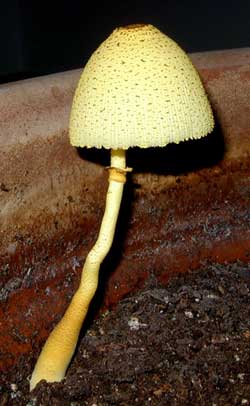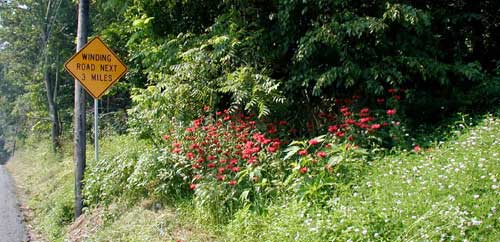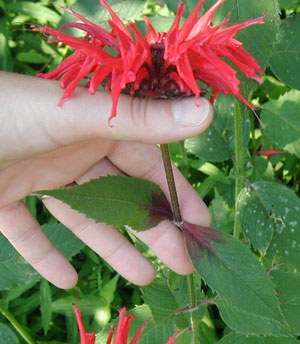Even though this blog concentrates on wildflowers, I can’t help but add some comments on the garden flowers and animals that we observe here in the mountains of Pennsylvania.
A small group of about a dozen turkeys were wandering around the edge of the woods around noontime today. The group appeared to be a couple mature females and some young ones. They were pecking at bugs and probably taking in a few stones from the gravel lane. At the slightest noise the turkeys scampered back into the woods.
The indoor plants are doing well in the warm conditions upstairs. The diffenbachia is blooming and showing off its pure white spathe.

Diffenbachia sporting a pure white blossom.
A mushroom appeared in the clay pot that holds a Norwegian pine. Never saw that before!

Norwegian pine pot with a yellow mushroom.
Driving along a country road we found a nice batch of Bee-Balm, Monarda didyma, growing near the edge of the road. The hummingbirds have to like this stuff — the blossoms are so red!

Bee balm by the roadside.

Monarda didyma flowers are brilliant red.
Identifying characters for Bee-Balm are that the blossoms are scarlet red and the bracts are red, too. Even some of the leaves have red coloration where they attach to the stems. Bee balm is a beautiful addition to any flower garden with the added benefit that it is a plant native to America.

Bee balm bracts are scarlet red.
Bee balm is also known as Oswego-Tea. A tea made from the leaves was used by Native Americans to treat colds, fevers, stomachaches, and colic, among other maladies.
Garden poppies have pretty much died out with the heat coming on in July, but they are being replaced by the zinnias, marigolds, dahlias and sunflowers.
2 thoughts on “Bee-Balm is Oswego-Tea”